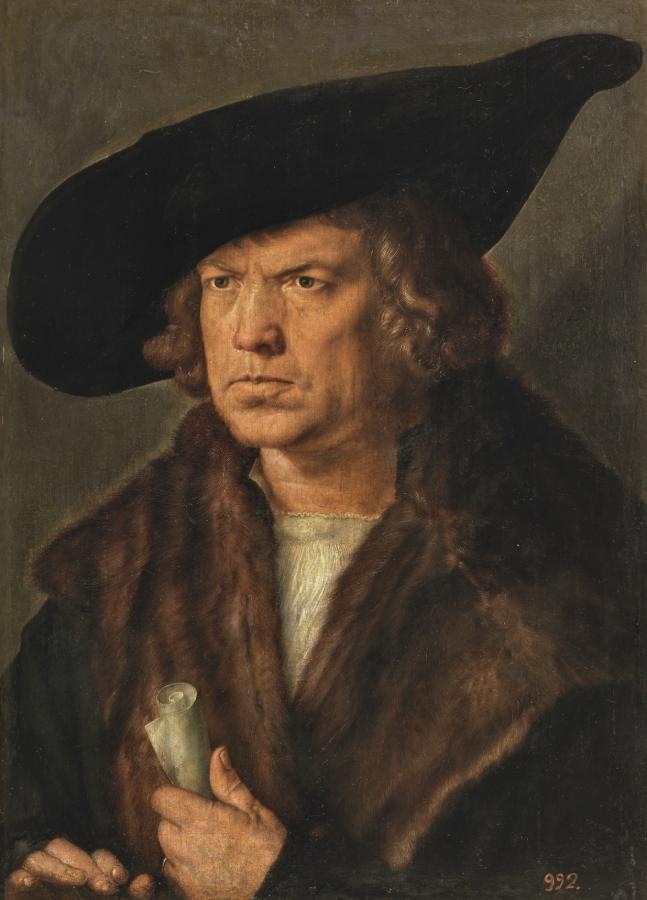Dürer, Albrecht (1471-1528)
Portrait of a Man
1521
Oil on panel, 50 x 36 cm
Museo del Prado, Madrid
This portrait is one of Dürer’s great creations. It offers a three-quarters view of an unidentified person. Dürer places him in front of a dark background that bears some touches of blue. The light enters from the left, bringing out the features of the face and hands and projecting the sitter’s shadow onto the background at the right, where the date and the painter’s monogram appear. A large hat brings out the model’s face, with an intense gaze and energetic character. The viewer’s eye is also drawn to the hands, and especially the rolled paper in the left hand, which undoubtedly expresses the model’s social circumstances.
The date is inscribed at the lower right of the painting and, while the last digit is difficult to identify, the work definitely corresponds to the painter’s final period. Although many authors prefer to read it as 1524, the canvas itself and the form in which its surface has been worked resemble portraits that Dürer made in the Netherlands through May 1521, or later that year after returning to Nuremberg. This typology -a half-length figure presented in a way that focuses attention on the face and hands- was employed by the artist in his first portraits, but abandoned in 1500. After that, he only returned to it in exceptional cases, such as his Portrait of Emperor Maximilian, from 1519 (Vienna, Kunsthistoriches Museum) or the portraits he made on his visit to Flanders in 1520–21, where it was very common among the local painters. From 1522, he made only bust portraits, which would make this likeness an exception if it were, in fact, painted in 1524. The same would be true of its surface work, which is very carefully rendered, with considerable attention to capturing the qualities of things. This reflects, and would appear to compete with, the work of Flemish painters -especially Quentin Massys-, which Dürer indeed did during his stay in the Netherlands. It is thus logical to suppose that he painted it in 1521, either in Flanders or in Nuremberg. The latter location is also suggested by the sitter’s sumptuous clothing, which is more in keeping with a German setting. Some authors have identified the model as councilman Hans Imhoff the Elder of Nuremberg, who died in 1522; treasurer Lornz Sterk, whose portrait hangs at the Isabella Stewart Gardner Museum in Boston; or Jobst Planfelt, the painter’s landlord in Antwerp. There is no real foundation for any of these suggestions, although all three are known to have been portrayed by Dürer.
This work is customarily associated with a portrait by Dürer that accompanied his self-portrait from 1498 in the collection of Charles I of England (Museo del Prado, P2179), both of which were gifts from the city of Nuremberg to the English monarch in 1632. However, the documentation of the latter works up to the time that they arrived in Spain mentions the self-portrait and a likeness of the painter’s father, supposedly the one from 1497, of which there is a replica at the National Gallery of London. That is what appears in the document of their purchase by politician Luis de Haro at the auction of Charles I’s property. De Haro gave the two works to Philip IV of Spain in 1654. The first clear reference to the present portrait as part of Spain’s Royal Collection is in the inventory of Charles III (1789-1790), where it is listed among the works hanging in Madrid’s royal Palace. From there, it entered the Museo del Prado in 1827. (Text drawn from Silva, P.: El Prado en el Ermitage, Museo Nacional del Prado, 2011, pp. 72-73).
